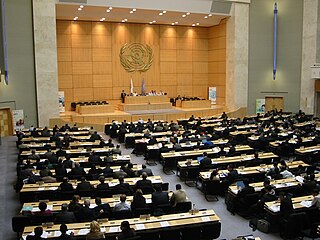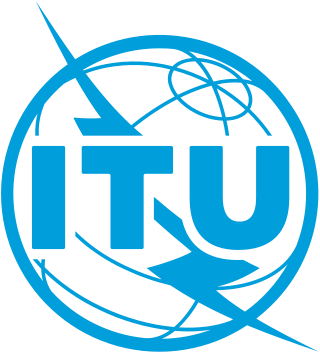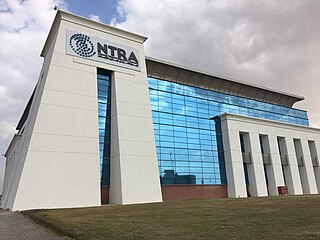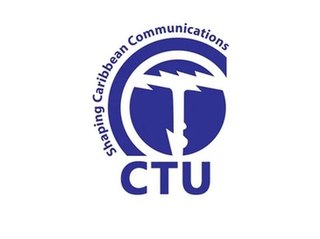
The European Conference of Postal and Telecommunications Administrations (CEPT) was established on June 26, 1959, by nineteen European states in Montreux, Switzerland, as a coordinating body for European state telecommunications and postal organizations. The acronym comes from the French version of its name Conférence européenne des administrations des postes et des télécommunications.
The International Telecommunication Union Telecommunication Standardization Sector (ITU-T) is one of the three Sectors (branches) of the International Telecommunication Union (ITU). It is responsible for coordinating standards for telecommunications and Information Communication Technology, such as X.509 for cybersecurity, Y.3172 and Y.3173 for machine learning, and H.264/MPEG-4 AVC for video compression, between its Member States, Private Sector Members, and Academia Members.

The International Telecommunication Union (ITU) is a specialized agency of the United Nations responsible for many matters related to information and communication technologies. It was established on 17 May 1865 as the International Telegraph Union, significantly predating the UN and making it the oldest UN agency. Doreen Bogdan-Martin is the Secretary-General of ITU, the first woman to serve as its head.

The (International) Radiotelephony Spelling Alphabet, commonly known as the NATO phonetic alphabet, is the most widely used set of clear code words for communicating the letters of the Roman alphabet. Technically a radiotelephonic spelling alphabet, it goes by various names, including NATO spelling alphabet, ICAO phonetic alphabet and ICAO spelling alphabet. The ITU phonetic alphabet and figure code is a rarely used variant that differs in the code words for digits.

The World Summit on the Information Society (WSIS) was a two-phase United Nations-sponsored summit on information, communication and, in broad terms, the information society that took place in 2003 in Geneva and in 2005 in Tunis. WSIS Forums have taken place periodically since then. One of the Summit's chief aims is to bridge the global digital divide separating rich countries from poor countries by increasing internet accessibility in the developing world. The conferences established 17 May as World Information Society Day.

Spectrum management is the process of regulating the use of radio frequencies to promote efficient use and gain a net social benefit. The term radio spectrum typically refers to the full frequency range from 1 Hz to 3000 GHz that may be used for wireless communication. Increasing demand for services such as mobile telephones and many others has required changes in the philosophy of spectrum management. Demand for wireless broadband has soared due to technological innovation, such as 3G and 4G mobile services, and the rapid expansion of wireless internet services.

World Telecommunication and Information Society Day is an international day proclaimed in November 2006 by the International Telecommunication Union Plenipotentiary Conference in Antalya, Turkey, to be celebrated annually on 17 May.
The Inter-American Telecommunication Commission or Comisión Interamericana de Telecomunicaciones (CITEL) is an entity of the Organization of American States. It was originally created as the Inter-American Electrical Communication Commission at the Fifth International American Conference in May 1923.
The African Telecommunications Union (ATU) is an organization in Africa that combines countries and mobile telecommunications providers in an attempt to dramatically increase development of the continent's information and communication technology (ICT) infrastructure.

Hamadoun Ibrahim Touré of Mali was Secretary General of the International Telecommunication Union (ITU), the specialized agency of the United Nations dedicated to information and communication technologies (ICTs), from 2007 to December 2014. He was re-elected for a second four-year term in 2010. Since 2007, he has worked to fulfil ITU's mandate to 'connect the world' and help achieve the Millennium Development Goals.

Malcolm Johnson is a British civil servant. He is the Deputy Secretary-General of the ITU and former Director of the Telecommunication Standardization Bureau (TSB) of the ITU Standardization Sector (ITU-T). He was elected Director by the ITU Plenipotentiary Conference, 2006 in Antalya, Turkey. He took office on 1 January 2007 and was re-elected at the ITU Plenipotentiary Conference 2010. At the ITU Plenipotentiary Conference 2014 in Busan, he was elected to a term as Deputy Secretary-General, and at the 2018 ITU Plenipotentiary Conference in Dubai, he was reelected to a second term.
The Global Standards Collaboration (GSC) started life as The Inter-regional Telecommunications Standards conference (ITSC) in 1990. This was an initiative of the T1 Committee of the United States who invited the other founding partner organizations ITU-T, ETSI and the Japanese TTC to the first ISC Meeting in Fredericksburg, VA. The goal was set by the “spirit of Melbourne”, stemming from a CCITT Plenary Assembly, to find a way of co-operation between Participating Standards Organizations (PSOs) from different regions of the world in order to facilitate global standardization within the ITU. The ITSC focussed its work on fixed telecommunications networks.
The Indian Telecommunications Service, widely known as ITS, and earlier known as 'Telegraph Engineering Service Class I' is one of the Central Civil Services under Group 'A' of the executive branch of the Government of India. The appointment to this service is done through Combined Engineering Services Exam held every year by Union Public Service Commission (UPSC) of India. The service was created to meet the techno managerial needs of the government in areas related to telecommunications. The Department of Telecommunications (DOT) had been managed for years by the officers of this permanent cadre, called the Indian Telecommunications Service (ITS).The officers of ITS work under restrictions and rules of Central Civil Services (Conduct) rules.
The Communications Authority of Kenya (CA) is the independent regulatory agency for the ICT industry in Kenya with responsibilities in telecommunications, e-commerce, broadcasting,cyber security, and postal/courier services. The CA is also responsible for managing the country's numbering and frequency spectrum resources, administering the Universal Service Fund (USF) as well as safeguarding the interests of users of ICT services.

Veena Rawat is an electrical engineer who specializes in telecommunications. Rawat was the first woman to graduate with a PhD in electrical engineering from Queen's University in Kingston, Ontario, Canada. She held executive positions managing programs related to radio frequency spectrum engineering for all wireless and space communication services in the Canadian Government, was the President of the Communications Research Centre (CRC), and was the Vice President and Ambassador to the International Telecommunication Union, for Blackberry, Advanced Technology Division, Canada. In 2014 she was awarded the Officer of the Order of Canada (OC) for her lifetime achievements and contributions at the national and international levels to wireless communications.

Anusha Rahman Ahmad Khan is a Pakistani politician who served as Federal Minister for Information Technology and Telecommunication, in Abbasi cabinet from April 2018 to May 2018. Previously she served as the Minister of State for Information Technology and Telecommunication of Pakistan from June 2013 to July 2017 in the third Sharif ministry and again from August 2017 to April 2018 in the Abbasi ministry. She had been a member of the National Assembly of Pakistan from 2008 to May 2018 representing the Pakistan Muslim League (N). In the 2024 Pakistani Senate election, Anusha emerged victorious in the senate seats reserved for women.

Houlin Zhao is a Chinese engineer who served as the Secretary-General of the International Telecommunication Union (ITU) from 2015 to 2022. He was first elected at the 2014 Plenipotentiary Conference in Busan, and re-elected at the 2018 Plenipotentiary Conference in Dubai. ITU is the specialized United Nations Agency for Information and Communication Technology (ICT), working on promotion, collaboration, and standardization.

The National Telecommunications Regulatory Authority, commonly known as NTRA, is the Egypt government-approved regulatory and competition authority that was established in accordance of the Egyptian telecommunication regulation law No. 10/ 2003 as the national Authority equipped to regulate and administer the telecommunications region. Regulating the competition environment between the operators inside the industry according to the Egyptian constitution was a huge mandatory case after the huge rate of telecommunication technology growth, as well as ensuring the availability of qualitative and green telecommunications services.
The following is a list of international organizations in which the Philippines officially participates.

The Caribbean Telecommunications Union (CTU) is an intergovernmental organization established by CARICOM in 1989, to facilitate development of the telecommunications sector in the Caribbean.













